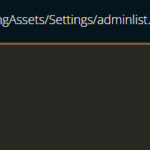Fivem Server Artifacts are a crucial component for anyone running a server, essentially acting as the server’s runtime environment. Recent discussions within the FiveM community have centered around the update frequency and labeling of these artifacts, particularly the meaning of “optional” and “recommended” tags. This article aims to clarify the current situation surrounding FiveM server artifact updates, drawing insights from developer communications to provide a clear understanding for server owners.
Decoding Artifact Labels: Optional and Recommended
Historically, FiveM server artifacts were labeled with “optional” and “recommended” tags to guide server owners in choosing the appropriate version. The “optional” label was typically assigned to newer versions, released shortly after significant changes. It was intended as a preliminary release, allowing for community testing before being broadly adopted. Subsequently, after a period of observation and assuming stability, a version would be promoted to “recommended”.
Alt text: A visual representation of different FiveM server artifact versions listed in a server management panel, highlighting “optional” and “recommended” labels.
However, the current development pace and nature of changes to FiveM artifacts have rendered this labeling system somewhat obsolete. The continuous stream of smaller updates, each carrying potential side effects, means the “optional” label no longer serves its original purpose of indicating a substantially different or potentially unstable release. In fact, the distinction between “optional” and “recommended” has become blurred, and maintaining these labels has become more of a legacy practice than a meaningful indicator of artifact quality or stability. Removing these labels is also not straightforward due to existing infrastructure and community expectations that have formed around them.
The Reality of Artifact Updates
The question of when FiveM server artifacts will be updated is a frequent one. While updates are still planned, providing a concrete timeline is challenging. Current development realities involve a “negative backlog velocity,” suggesting that the pace of addressing pending tasks is slower than the rate at which new issues and changes arise. Developer bandwidth is limited, and basic project maintenance is facing challenges.
Alt text: Diagram illustrating the stages of a server artifact update process, from development and testing to release and community feedback.
Furthermore, community feedback and the handling of reported issues play a significant role in the update process. Instances where users encounter regressions but fail to provide detailed reports or engage constructively can further complicate and slow down the process. The need to address a multitude of concerns, both technical and community-related, makes planning and prioritization a complex task.
What This Means for Server Owners
For FiveM server owners, the current artifact update situation implies a few key considerations. Relying heavily on the “optional” or “recommended” labels to dictate artifact selection may no longer be the most effective strategy. Instead, staying informed about community discussions and potentially testing newer “optional” versions in a controlled environment might be more beneficial to ensure compatibility and access to the latest features and fixes.
Alt text: A server dashboard interface displaying real-time server status and the currently installed FiveM server artifact version, emphasizing monitoring for optimal performance.
While the future update schedule remains uncertain, understanding the underlying challenges and the evolution of the artifact labeling system allows server owners to make more informed decisions about their server infrastructure. Keeping abreast of official announcements and community discussions will be crucial for navigating the ongoing development of FiveM server artifacts.

